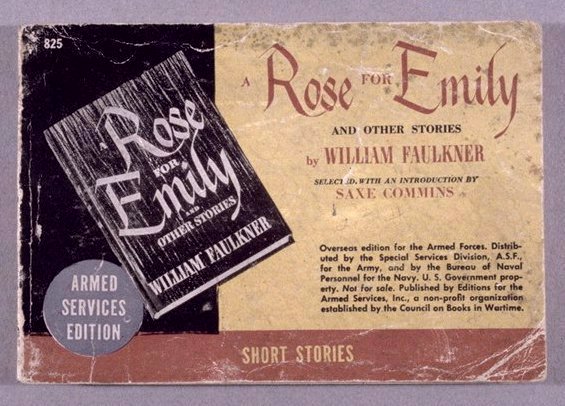



授課教師:
陳吉斯
E-mail: kiss7445@mail.tku.edu.tw
Latest update: 2003/11/16
 |
 |
  |
Emily Grierson,
Homer Barron, a day worker
Colonel Sartoris,
Judge Stevens,
Wyatt (old lady)
Two of Emily's cousins
Town people
The difficulty of reading this story lies in
the unusual narrative sequence (non-chronological) and point of view
("We"). This non-chronological sequence confuse the reader awareness
of time and causality. The narrator's scope of perception is
limited. These two traits make the story read like a detective story. To know
what happen, you may have to make a chronology of the events. The chronology
will help you to perceive the causality obscured by the narrator. Here is a
chronology of the events in "A Rose for Emily."
| Event Order | Time (Emily's age) | Narrative order | What happen |
| 1 | Emily was 30 | II. 26-7 | When Emily was 30, Emily’s
father died (II. paragraph. 26) Emily refused to accept her father’s death. When the town people forced to bury her father, she broke down. (II. Paragraph 27) |
| 2 | III. 30, 33 | --Emily was sick for a long time. --In the summer after the Emily’s father, the town had a contract for paving the sidewalks. --Emily acquainted with a day worker, Homer Barron (a Yankee—a big, dark, ready man, with a big voice and eyes lighter than his face). (III. Paragraph 30) --The town ladies started to gossip about the love affair. “Poor Emily.” (III. Paragraphs 33). |
|
| 3 | (32) | III. 34-40 | --Emily bought rat poison.
(III. Paragraphs 34-40) |
| 4 | (32) | IV. 43 | The next day after Emily bought the arsenic, the town people thought Emily would kill herself. (IV. Paragraph 43) |
| 5 | (32) | IV. 44 | Disturbances of the love affair: --Town people (especially the ladies) disagreed and gossiped. ”She will persuade him yet”, because Homer Barron had remarked—he liked men (IV. Paragraph 43). --Some town ladies interfered, and for the Baptist minister to called upon her. --The next Sunday, they (Emily and Homer) again drove about the street. The following day, the minister’s wife wrote to Emily’s relations in Alabama. (IV. 44) |
| 6 | (32) | IV. 45 | Emily went to the jeweler’s and order a man’s toilet set in silver, with the letter H.B. on each piece. She also bought a complete outfit of men’s clothing, including a nightshirt. The town people believed that “They are married.” (IV, 45) |
| 7 | 32 | IV. 46, 47 | --The
town people were surprised
that Homer Barron had gone. (IV. 46). --”Within three days Homer Barron was back in town. A neighbor saw the Negro man admit him at the kitchen door at dusk one evening”. (IV. 46) -- "And that was the last we saw of Homer Barron. And of Miss Emily for some time." (IV. 47) |
| 8 | 32 |
II. 15-24 | Two years after the death of Emily’s
father:
Emily was 32 --Emily’s sweetheart “the one we believed would marry her had deserted her.” (II, Paragraph 15) --The smell developed. After Emily’s neighbor’s complaint, Judge Stevens (80 years old) investigated the source of the smell without result. (II. Paragraphs 15-24) |
| 9 | 40, In 1894 |
IV. 49 I. 2 |
--When Emily was about 40, she
started to give china painting lessons to the ladies (daughters and
granddaughters of Colonel Sartoris’s contemporaries). This lasted for
about six or seven years. Meanwhile her taxes had been remitted. (IV. 49) --In 1894, Colonel Sartoris remitted the taxes of Miss Emily Grierson. (I. 2) |
| 10 | 52 | II. 14 | Colonel Sartoris died—Emily was 52. (II. Paragraph 14) |
| 11 | 52~54 | I. 5 | Emily was about 52~54. Emily stopped given china painting lesson to the town ladies—Since that time, nobody visited the Grierson house.. (I. Paragraph 5) |
| 12 | 52~54 | IV. 50 | The second generation became the backbone of the town. They stopped sent girls to Miss Emily’s painting class. “When the town got free postal delivery Miss Emily alone refused to let them fasten the metal numbers above her door and attach a mailbox to it. She would not listen to them.” (IV. 50) |
| 13 | 62 | I. 4-14 | 32 (30 +2) years after the death of
Emily’s father, and 10 years after the death of Colonel Sartoris: Emily was 62 (“a small, fat woman in black, . . . . She looked bloated, like a body long submerged in motionless water, and of that pallid hue.”) --The town aldermen asked Emily Grierson to pay taxes, but she refused. (I. Paragraphs 4-14) |
| 14 | 74 | IV. 48, 53 |
Emily died at the age of 74. (IV. 48).” “She died in one of the downstairs rooms, in a heavy walnut bed with a curtain, her gray head propped on a pillow yellow and moldly with age and lack of sunlight.” (IV. 53) |
| 15 | 74 | I. 1-2 | The town people went to Miss Emily Grierson’s funeral. (I. 1-2) |
| 16 | 74 | V. 55 | Miss
Emily was put “beneath a mass of bought flowers, with the crayon face of
her father musing profoundly above the bier. . . .” (V. 55.) Two female cousins came to the funeral. (Only two) (V. 55) |
| 17 | 74 | V. 56-60 |
After the funeral, the town people intruded into
Emily’s bedroom, which no one had seen in forty years. Emily’s room was furnished as for a bridal, with the curtain of rose color. (Rose was mentioned only in this paragraph!) And they found a man’s body lay in the bed, with a long strand of iron-gray hair. (V. 56-60) |
The question is why the author will choose such an unusual plotting?
1.
Discuss the theme:
A.
What does the title suggest? When will you send rose to somebody? What
does the "rose" symbolize?
Have anyone sent "a rose" for Emily?
B.
Is Emily Grierson a victim or a criminal? Why did Emily kill Homer
Barron?
C.
What are the significance of the depictions of Emily as
"monument," "tableau," and "idol in a niche" ?
D. How were the town people's perceptions of the facts concerning Emily and Homer misled by their values?
2.
Discuss the techniques:
A.
Symmetry in the five-parts structure
B.
The function of gossiping
C. Who is the narrator? Can you recognize the sex, age, social status of the narrator? What is the narrator's relation to Emily? What kind of value system does the narrator represent?
D.
How does Faulkner's non-chronological narration help to create sympathy for
Emily? How does such a
narration create a contrast of values and a contrast of the past and the
present.
3.
Compare Faulkner's "A Rose for Emily" with Gilman's
"Yellow Wall-paper":
A.
The status of woman
B.
Narrative point of view